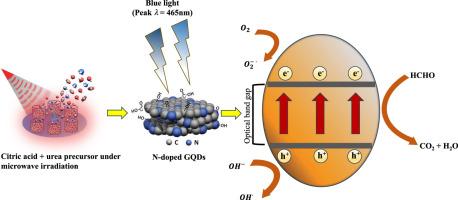不同光照条件下氮掺杂石墨烯量子点对甲醛的光催化降解
IF 6.3
3区 工程技术
Q1 ENGINEERING, CHEMICAL
Journal of the Taiwan Institute of Chemical Engineers
Pub Date : 2025-08-01
DOI:10.1016/j.jtice.2025.106262
引用次数: 0
摘要
本文研究了氮掺杂石墨烯量子点(n掺杂GQDs)在模拟室内照明下的光催化降解甲醛。本研究遵循ASHRAE 145.1室内空气质量标准,采用突破容量测试系统(BTCTS)评估甲醛去除效率。氮掺杂GQDs是一种新型纳米材料,在LED可见光下表现出优异的甲醛分解效果。采用微波辅助法制备了这些N-GQDs,并用XRD、HR-TEM、XPS和UV-Vis光谱对其进行了表征。研究人员使用了5种甲醛浓度,分别是台湾环保局0.08 ppm标准的8到30倍,来评估不同暴露水平下n掺杂GQDs的性能。利用四种常见的室内光源,分析了光谱对降解的影响。结果一致表明,在所有测试条件下,n掺杂GQDs都能有效降低甲醛浓度。蓝光(400-500 nm)由于激发波长与N-GQDs匹配,降解效率最高。光催化过程符合准二级动力学模型,表明了良好的反应途径。这些发现突出了n掺杂GQDs作为室内空气净化光催化剂的潜力。在建筑材料中掺入n掺杂GQDs可以显著改善室内空气质量,从而保护居住者的健康和福祉。本文章由计算机程序翻译,如有差异,请以英文原文为准。

Photocatalytic degradation of formaldehyde by nitrogen-doped graphene quantum dots under various light conditions
This study investigates the photocatalytic degradation of formaldehyde by nitrogen-doped graphene quantum dots (N-doped GQDs) under simulated indoor lighting. Adhering to ASHRAE Standard 145.1 for indoor air quality, the research utilized a breakthrough capacity test system (BTCTS) to evaluate formaldehyde removal efficiency. N-doped GQDs, a novel nanomaterial, demonstrated exceptional formaldehyde decomposition efficacy under LED visible light. These N-GQDs were synthesized via a microwave-assisted method and characterized by XRD, HR-TEM, XPS, and UV–Vis spectroscopy.
Five formaldehyde concentrations, 8 to 30 times the Taiwanese EPA's 0.08 ppm standard, were used to assess N-doped GQDs' performance across varying exposure levels. The impact of light spectrum on degradation was analyzed using four common indoor light sources. Results consistently showed N-doped GQDs effectively reducing formaldehyde concentrations under all tested conditions. Blue light (400–500 nm) yielded the highest degradation efficiency due to its matching excitation wavelength with N-GQDs. The photocatalytic process followed a pseudo-second-order kinetic model, suggesting a favorable reaction pathway. These findings highlight N-doped GQDs' potential as promising photocatalysts for indoor air purification. Integrating N-doped GQDs into building materials can significantly improve indoor air quality, thereby protecting occupant health and well-being.
求助全文
通过发布文献求助,成功后即可免费获取论文全文。
去求助
来源期刊
CiteScore
9.10
自引率
14.00%
发文量
362
审稿时长
35 days
期刊介绍:
Journal of the Taiwan Institute of Chemical Engineers (formerly known as Journal of the Chinese Institute of Chemical Engineers) publishes original works, from fundamental principles to practical applications, in the broad field of chemical engineering with special focus on three aspects: Chemical and Biomolecular Science and Technology, Energy and Environmental Science and Technology, and Materials Science and Technology. Authors should choose for their manuscript an appropriate aspect section and a few related classifications when submitting to the journal online.

 求助内容:
求助内容: 应助结果提醒方式:
应助结果提醒方式:


